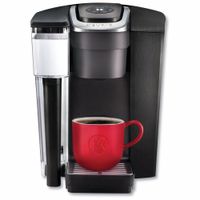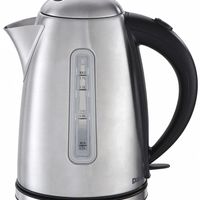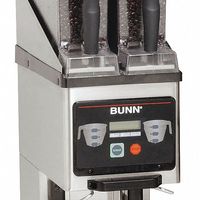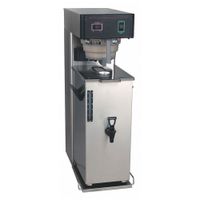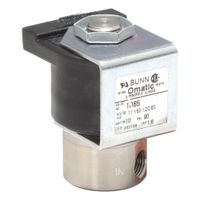Call +(254) 703 030 000 / 751 483 999 / 721 704 777
- Home
- Furnishings Appliances Hospitality
- Appliances
- Coffee Tea Brewing Equipment
Frequently Asked Questions
What is the best coffee maker for home use?
The best coffee maker for home use depends on individual preferences, but a popular choice is the Technivorm Moccamaster. Known for its durability and high-quality construction, it consistently brews coffee at the optimal temperature range of 196-205°F, ensuring excellent flavor extraction. The Moccamaster features a copper heating element and a unique 9-hole outlet arm that evenly saturates coffee grounds, resulting in a balanced and rich cup. It is also SCA-certified, meaning it meets the Specialty Coffee Association's rigorous standards for performance and quality.
For those who prefer convenience, the Breville Bambino Plus is an excellent option for espresso lovers. It heats up in just 3 seconds and offers automatic milk frothing, making it easy to create café-quality drinks at home. Its compact design is perfect for small kitchens, and it provides consistent pressure for optimal espresso extraction.
If versatility is a priority, the Ninja Hot and Cold Brewed System is a great choice. It can brew both hot and cold coffee, as well as tea, and offers multiple brew sizes and styles, including classic, rich, over ice, and specialty brews. Its built-in frother allows for easy preparation of lattes and cappuccinos.
For those on a budget, the Hamilton Beach FlexBrew offers both single-serve and full-pot brewing options, accommodating ground coffee and K-Cups. It provides flexibility and convenience without compromising on quality.
Ultimately, the best coffee maker for home use will align with your specific needs, whether it's the quality of brew, ease of use, versatility, or budget.
How do I choose the right coffee grinder?
To choose the right coffee grinder, consider the following factors:
1. **Grind Consistency**: Opt for a burr grinder over a blade grinder. Burr grinders provide uniform grind size, essential for consistent flavor extraction. Blade grinders can produce uneven particles, affecting taste.
2. **Grind Settings**: Look for a grinder with multiple grind settings. This flexibility allows you to adjust the grind size for different brewing methods, such as espresso, drip, or French press.
3. **Capacity**: Consider how much coffee you brew at once. If you make large batches, choose a grinder with a larger hopper. For single servings, a smaller capacity may suffice.
4. **Material and Durability**: Stainless steel or ceramic burrs are durable and maintain sharpness longer. Ensure the grinder's body is made of sturdy materials to withstand regular use.
5. **Ease of Cleaning**: Choose a grinder that is easy to disassemble and clean. Removable parts and accessible burrs simplify maintenance, preventing old coffee residues from affecting flavor.
6. **Noise Level**: If noise is a concern, look for grinders known for quieter operation. Burr grinders tend to be quieter than blade grinders.
7. **Speed and Heat**: High-speed grinders can generate heat, potentially affecting coffee flavor. Opt for a grinder with a slower speed to preserve the beans' integrity.
8. **Price**: Set a budget. Manual grinders are generally more affordable but require more effort. Electric grinders offer convenience but can be pricier.
9. **Brand Reputation and Reviews**: Research brands known for quality and reliability. Read user reviews to gauge performance and customer satisfaction.
10. **Size and Design**: Consider the grinder's size and design to ensure it fits your kitchen space and aesthetic preferences.
By evaluating these factors, you can select a coffee grinder that meets your brewing needs and enhances your coffee experience.
What is the difference between a coffee maker and an espresso machine?
A coffee maker and an espresso machine are both used to brew coffee, but they differ significantly in their brewing methods, pressure, grind size, and the type of coffee they produce.
A coffee maker, often referred to as a drip coffee maker, uses a relatively simple process. It heats water and drips it over ground coffee contained in a filter. The water then passes through the coffee grounds, absorbing flavors and oils, and drips into a carafe or pot. This method typically uses medium to coarse coffee grounds and does not require high pressure. The result is a milder, larger volume of coffee, often referred to as "drip coffee."
In contrast, an espresso machine uses high pressure to force hot water through finely-ground coffee. This process, known as "pulling a shot," typically takes 25-30 seconds and results in a small, concentrated coffee shot with a rich flavor and a layer of crema on top. Espresso machines require finely ground coffee and can produce a more intense and robust flavor compared to drip coffee. They are also more versatile, allowing for the creation of various coffee drinks like lattes, cappuccinos, and macchiatos by adding steamed milk.
Espresso machines are generally more complex and expensive than coffee makers, often requiring more maintenance and skill to operate. They are favored by those who prefer a stronger, more concentrated coffee experience, while coffee makers are ideal for those who enjoy a simpler, larger volume of coffee.
How do I clean and maintain my coffee brewing equipment?
To clean and maintain your coffee brewing equipment, follow these steps:
1. **Daily Cleaning:**
- **Drip Coffee Maker:** After each use, discard the used coffee grounds and wash the carafe, filter basket, and any removable parts with warm, soapy water. Rinse thoroughly and dry.
- **Espresso Machine:** Purge the steam wand after each use by wiping it with a damp cloth and running steam through it. Empty the portafilter and rinse it.
- **French Press:** Disassemble and wash all parts with warm, soapy water. Use a brush to remove any coffee residue from the mesh filter.
2. **Weekly Cleaning:**
- **Drip Coffee Maker:** Run a cycle with a mixture of equal parts water and white vinegar to descale the machine. Follow with two cycles of clean water to rinse.
- **Espresso Machine:** Backflush with a blind filter and a small amount of espresso machine cleaner. Rinse thoroughly.
- **Grinder:** Brush out any coffee grounds and use a vacuum to remove fine particles. Wipe the exterior with a damp cloth.
3. **Monthly Maintenance:**
- **Drip Coffee Maker:** Check for any buildup in the water reservoir and clean with vinegar if necessary.
- **Espresso Machine:** Remove and soak the portafilter and baskets in a solution of water and espresso cleaner. Clean the group head with a brush.
- **Grinder:** Deep clean by disassembling and washing removable parts. Use grinder cleaning tablets if recommended by the manufacturer.
4. **General Tips:**
- Always refer to the manufacturer’s instructions for specific cleaning guidelines.
- Use only recommended cleaning products to avoid damage.
- Regularly check for wear and tear, replacing parts as needed to ensure optimal performance.
What is the best electric kettle for brewing tea?
The best electric kettle for brewing tea is the Fellow Stagg EKG Electric Pour-Over Kettle. This kettle is highly regarded for its precision, design, and functionality, making it ideal for tea enthusiasts. It features variable temperature control, allowing you to set the exact temperature needed for different types of tea, such as green, black, or oolong, ensuring optimal flavor extraction. The temperature can be adjusted in one-degree increments, providing precise control.
The Stagg EKG also boasts a sleek, minimalist design with a matte finish, making it a stylish addition to any kitchen. Its gooseneck spout ensures a controlled and steady pour, which is crucial for brewing tea, as it allows for even saturation of the tea leaves. The kettle has a 1200-watt quick-heating element, ensuring that water reaches the desired temperature swiftly.
Additionally, the kettle includes a hold function that maintains the set temperature for up to 60 minutes, allowing for flexibility in brewing time. The LCD screen displays both the set temperature and the real-time temperature, providing clear and easy monitoring.
The build quality is robust, with a stainless steel body that ensures durability. The kettle's ergonomic handle provides a comfortable grip, making pouring effortless. While it is on the higher end of the price spectrum, its features and performance justify the investment for serious tea brewers.
Overall, the Fellow Stagg EKG Electric Pour-Over Kettle combines precision, style, and functionality, making it the best choice for brewing tea.
How do I froth milk for a cappuccino or latte?
To froth milk for a cappuccino or latte, follow these steps:
1. **Choose the Right Milk**: Whole milk froths best due to its fat content, but you can use 2% or non-dairy alternatives like almond or oat milk.
2. **Prepare the Milk**: Pour cold milk into a stainless steel frothing pitcher. Fill it to about one-third full to allow room for expansion.
3. **Steam Wand Preparation**: Purge the steam wand by turning it on briefly to remove any water condensation.
4. **Position the Wand**: Submerge the steam wand tip just below the milk surface. Tilt the pitcher slightly to create a whirlpool effect.
5. **Aerate the Milk**: Turn on the steam wand. Keep the tip near the surface to introduce air, creating a hissing sound. This is called stretching the milk. Do this until the milk volume increases by about 50%.
6. **Heat the Milk**: Once aerated, submerge the wand deeper into the milk to heat it. Aim for a temperature of 150°F (65°C). Use a thermometer or touch the pitcher; it should be too hot to hold for more than a few seconds.
7. **Create Microfoam**: Move the pitcher in a circular motion to integrate the foam and milk, creating a smooth, velvety texture.
8. **Tap and Swirl**: Tap the pitcher on the counter to remove large bubbles. Swirl the milk to maintain a glossy texture.
9. **Pour the Milk**: For a cappuccino, aim for a 1:1 ratio of espresso to milk foam. For a latte, use more steamed milk with a small amount of foam on top.
10. **Clean the Wand**: Wipe the steam wand with a damp cloth and purge it again to prevent milk residue buildup.
Enjoy your perfectly frothed milk in your cappuccino or latte!
What is the best way to brew iced tea at home?
To brew the best iced tea at home, start by selecting high-quality loose leaf tea or tea bags, depending on your preference. Black, green, or herbal teas are popular choices. For a classic iced tea, black tea is often preferred.
1. **Boil Water**: Use fresh, filtered water and bring it to a boil. For black tea, the water should be around 200-212°F (93-100°C). For green or white tea, let the water cool slightly to about 170-185°F (77-85°C).
2. **Steep Tea**: Use about 1 teaspoon of loose leaf tea or 1 tea bag per cup of water. Pour the hot water over the tea and let it steep. Black tea typically requires 3-5 minutes, while green tea needs 2-3 minutes. Over-steeping can cause bitterness.
3. **Sweeten (Optional)**: If you prefer sweetened iced tea, add sugar or a sweetener of your choice while the tea is still warm so it dissolves easily. Adjust to taste.
4. **Cool Down**: Once steeped, remove the tea leaves or bags. Allow the tea to cool to room temperature. For a quicker method, you can use the hot brew over ice method by pouring the hot tea directly over a glass filled with ice.
5. **Chill**: Transfer the tea to a pitcher and refrigerate for at least 2-3 hours until thoroughly chilled.
6. **Serve**: Serve the iced tea over ice cubes in a glass. Garnish with lemon slices, mint leaves, or fruit for added flavor.
7. **Variations**: Experiment with flavors by adding herbs like mint or basil, or fruits like berries or citrus during the steeping process.
This method ensures a refreshing, flavorful iced tea perfect for any occasion.
